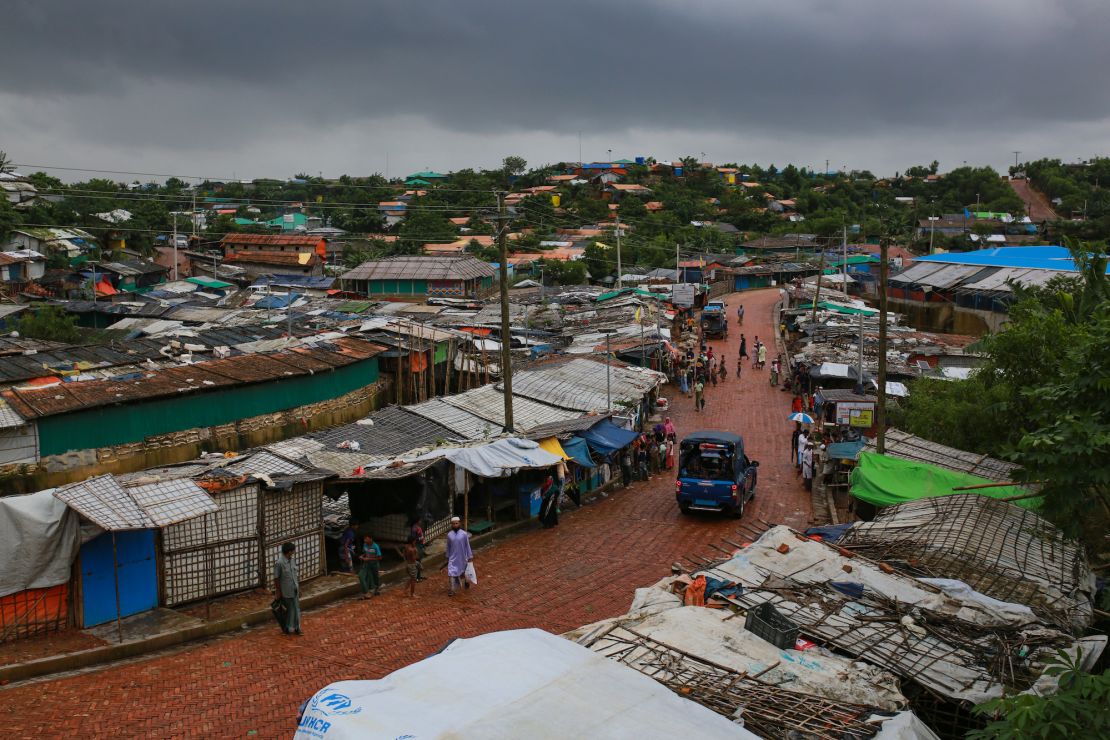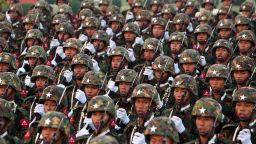CNN
—
Renewed fears of ethnic cleansing against the stateless Rohingya Muslim community are mounting after reports that hundreds of people, including women and children, were killed by drone strikes while fleeing violence in Myanmar’s western Rakhine state last week.
Videos shared widely on social media and geolocated by CNN showed dozens of bodies strewn across the muddy banks of the Naf River that separates Myanmar from Bangladesh.
In one video, geolocated to the western edge of Maungdaw township’s Myo Ma ward on the banks of the river, a man sobs as he walks down a muddy path stained with blood. The bodies of men, women and children can be seen lying in the sand, grass and pools of water. Piles of their colorful clothing and belongings are scattered half-submerged around them.
Witnesses and Rohingya activists told CNN that a series of drone strikes on August 5 hit civilians fleeing fighting and violence in their villages in Maungdaw, northern Rakhine. The displaced families had been waiting to cross the river to Bangladesh at the time of the attack, they said.
Unverified reports put the death toll at about 200 people, which, if confirmed, would be one of the deadliest attacks against civilians in Myanmar’s three-year civil war, a conflict that broke out following the military’s 2021 coup.
Witnesses and activists who spoke to CNN claim the Arakan Army (AA), a powerful ethic armed group fighting the Myanmar military, were responsible for last Monday’s attacks on the Rohingya.
The AA has denied involvement, saying in a statement that “these deaths did not occur in areas under our control and are not related to our organization.”
But it added that it’s carrying out an offensive near Maungdaw to “completely capture” remaining military camps and had been warning civilians since June 16 to evacuate Muangdaw as quickly as possible.
The AA said it was “saddened to learn” that Rohingya fleeing the town had “reportedly” been killed by “small arms fire, bombings, drownings, airstrikes or massive explosions near the coast of Maungdaw, causing great distress.” And it blamed the deaths on the Myanmar military and allied Rohingya armed groups.
However, Myanmar’s military junta blamed the AA for attacks in Maungdaw in a state media report that claimed “AA terrorists fired at townships, wards and villages in Rakhine state using heavy weapons and drones and tortured the villagers.”
CNN cannot independently attribute the reports of responsibility, or verify the number of people who were killed. A junta-imposed internet and telecoms blackout, and restrictions on access in the state is making it almost impossible for journalists, activists and international monitoring groups to verify exactly what is unfolding.
Myanmar’s Rohingya have long suffered mass atrocities and forced displacement that many – including United Nations experts – consider to be genocide, perpetrated by the country’s military.
The latest violence has echoes of attacks on the Rohingya in 2016 and 2017, when Myanmar’s military launched a brutal campaign of killing, rape and arson that is currently subject to a genocide investigation at the International Court of Justice.
Fires and ‘forced conscription’
Reports by activists and local media suggest attacks in villages close to Myanmar’s border with Bangladesh, along the Naf River, continued in the days after August 5, with accounts of more deaths, sexual violence, the burning of homes and forced conscription by the AA.
“The fighting is increasing,” Nay San Lwin, a Rohingya activist and co-founder of the Free Rohingya Coalition, who spoke with residents in Maungdaw, told CNN Monday. “There are about 4,000 to 5,000 people fleeing to AA-controlled areas and some 5,000 people in the downtown area.”
Remote sensing data curated by NASA’s Fire Information for Resource Management System and viewed by CNN also suggests fires began in downtown Maungdaw in the early hours of August 6. Satellite imagery similarly indicates thermal scarring in Rohingya-majority areas of Maungdaw, though fire damage does not appear extensive.
In a statement on Friday, medical NGO Doctors Without Borders said its teams in Cox’s Bazar, Bangladesh treated 39 Rohingya people who had crossed from Myanmar with “violence-related injuries” including mortar shell injuries and gunshot wounds.
Patients, more than 40% of whom were women and children, described seeing people bombed while trying to board boats across the river and others said they saw hundreds of bodies on the riverbanks, said the statement from the NGO, also known as Medecins Sans Frontieres (MSF).
MSF said it’s the first time in a year their staff have seen serious injuries on this scale.
“It is clear that the safe space for civilians in Myanmar is shrinking more each day, with people… forced to make perilous journeys to Bangladesh to seek safety,” said Orla Murphy, MSF country representative in Bangladesh.
Forced to flee
Fighting between the AA and the Myanmar military have intensified around Maungdaw in recent weeks as the rebel group continues its offensive to seize more military posts and towns from the junta.
Hasan, a 24-year-old student who spoke with CNN by phone from Bangladesh on Friday, said he fled his village north of Maungdaw on August 5, following a series of drones and artillery attacks that he said were launched by the AA.
“In the first drone attack, 30 people were killed and in the second attack… I saw 50 people dead,” he said. Two villages were set on fire, he added.
Hasan, who goes by one name, was shot in his right leg as he fled to the river, according to X-ray and medical records he shared with CNN.
But Hasan said he is one of the lucky ones. He managed to board a boat and cross the 2-mile stretch of river to Bangladesh.
“It was not easy to cross the border. During the attack I got to a boat. After one hour waiting in the middle of the river, we crossed the Bangladesh border,” he said. “People were dead in the river… Luckily I safely reached Bangladesh.”

On Thursday, doctors removed shrapnel from Hasan’s leg at an MSF-run field hospital in Cox’s Bazar, where an estimated 1 million Rohingya people live in squalid and overcrowded conditions in sprawling refugee camps.
Mohammad Elias, another Rohingya resident of Maungdaw, said AA soldiers attacked his village last week, killing residents.
“I saw it with my eyes. The AA launched a drone attack. They came to our houses, they came into our villages,” said Elias, who spoke to CNN by phone from the camps in Bangladesh. “I saw some of the young men (killed) in knife attacks … a lot of people were killed, men, women and children – my family members.”
On the evening of August 5, Elias said he sheltered under a bridge as residents were attacked with guns and drones.
He managed to cross by boat to Bangladesh with his brother and father, who was shot in the knee.
Elias said his sister and niece tried to flee on another boat but were detained by Bangladeshi law enforcement.
He doesn’t know what has happened to them, he said.
“I don’t have money, I don’t have shelter,” Elias said. “We need justice, innocent people are dying … We need a ceasefire.”
CNN has reached out to Bangladesh’s Border Guard Force for comment following reports that hundreds of Rohingya refugees had been detained. Reports suggested some people had been sent back to Myanmar. CNN cannot independently verify these reports.
In its statement, the AA said it “condemns all forms of violence against civilian population” and “clearly instructs its members to adhere to military discipline … and international humanitarian laws during warfare.”
Fears of ethnic cleansing
A new report from Human Rights Watch released Tuesday said both the Myanmar junta forces and the AA have committed extrajudicial killings and widespread arson against Rohingya and other civilians in Rakhine state in recent months, “raising the specter of ethnic cleansing.”
In May, the AA seized the town of Buthidaung, east of Maungdaw. Subsequent reports from activists and relatives emerged of extrajudicial killings, fighters torching and looting Rohingya neighborhoods, and forcing thousands of people to flee.
Forced recruitment of Rohingya men and boys is stoking religious tensions between the Rohingya Muslim and Rakhine Buddhist communities, the report said.
“Ethnic Rohingya and Rakhine civilians are bearing the brunt of the atrocities that the Myanmar military and opposition Arakan Army are committing,” said Elaine Pearson, Asia director at Human Rights Watch.
“Both sides are using hate speech, attacks on civilians, and massive arson to drive people from their homes and villages, raising the specter of ethnic cleansing.”
CNN’s Michael Mitsanas and Nyah Peebles contributed reporting.









